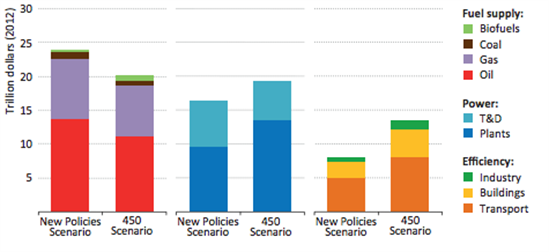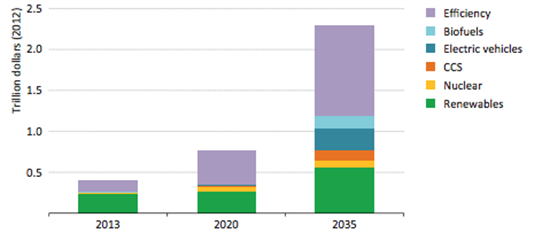The world needs to spend $48 trillion between now and 2035 in order to keep the lights on and meet rising demand for energy, the International Energy Agency says in its World Energy Investment Outlook. The bad news is that if you spend all of that money, the IEA’s best guess is you get a 4 degree world.
The good news is that if we can collectively muster another $5 trillion – then we can keep the lights on and avoid dangerous climate change, according to the IEA.
IEA chief economist Fatih Birol says:
“The difference is not bigâ?¦ The main issue is not to raise additional capital but to reallocate investmentsâ?¦ The world that we would like to see depends on the right investment decisions.”
How much does the world need to spend?
Whatever happens to the climate, the world’s energy systems have huge investment needs over the next two decades.
The IEA thinks we will need to spend nearly $25 trillion on new coal, oil and gas supplies between now and 2035 (far left, below).
That’s to meet its ‘new policies scenario’ where countries make some new efforts to tackle emissions but there is no global concerted action on climate.
Another $16 trillion will need to be spent on power stations and the transmission networks that distribute power to homes and businesses (blue columns, centre). And $8 trillion will be needed to make homes, cars and factories more efficient (below right).

Source: IEA World Energy Investment Outlook
The money’s needed to deal with a combination of old power stations closing down, rising demand for energy in rapidly developing economies, and existing oil and gas supplies drying up.
In fact, a whopping 80 per cent of the spending on oil and gas will go towards replacing existing supplies as they decline – like the fields of the North sea. The IEA calls this “running fast to stand still”, and it accounts for three fifths of the investment in new power stations too.
If the world agrees on ambitious action to tackle climate change, it can turn down the path the IEA calls “450 scenario”. This would limit emissions to a level that should avoid dangerous climate change of more than 2 degrees.
The biggest difference on this path is that spending on energy efficiency is a lot higher – $13 trillion between now and 2035 rather than $8 trillion. There would also be higher spending on renewable energy and lower investment in oil and gas.
While these sums are obviously very large, the difference in overall spending between a 2 and 4 degree world is not big, Birol says. It’s more a question of where that money goes.
Why won’t a 2 degrees world happen on its own?
The IEA says it is in favour of a 2 degrees world – well, aren’t we all?
So given the relatively small difference in investment required, it might seem surprising that the IEA doesn’t expect it to happen. Its report says:
“National policies have not been sufficient, in the absence of a global climate agreement, for this shift in investment flows to take place at the necessary rate and speed.”
It says that current policies and low prices on carbon emissions are insufficient to switch investment towards low-carbon sources and energy efficiency. A breakthrough in global climate talks in Paris in 2015 will be “vital” to change that investment landscape, it says.
For the purposes of its 2 degree scenario the IEA assumes a deal would lead to a global carbon price covering power generation and industry after 2020. It also assumes fossil fuel subsidies are phased out by 2035, except in the Middle East.
Where should our 2 degrees money be going?
Let’s for a minute imagine that an ambitious deal like this really does emerge from Paris. Where would we need to be spending our 2 degrees cash?
Energy efficiency is central to the IEA’s 2 degrees world (pink chunk, below).

Source: IEA World Energy Investment Outlook
Investing in more efficient cars and homes means the world will need less expensive oil and gas. It will also reduce the need to build more power stations.
Energy efficiency is important even in a 4 degree world, with the IEA expecting spending to increase four-fold from $130 per year today to $550 billion per year in 2035. For a 2 degree world that’ll have to be double again to $900 billion a year in 2035.
Investment in renewables will have to surge too, increasing three-fold on today’s levels to around $700 billion per year in 2035. It has already increased five-fold from $60 billion in 2000 to $300 billion in 2011.
More recently that figure has fallen back to $250 billion in 2013. That’s for two reasons: Government renewable energy subsidies have been cut in countries like Spain, and each unit of renewables capacity has become cheaper to install.
The first point illustrates clearly why the report strongly argues for regulatory and policy certainty, to ensure investors put their hands in their pockets. A report out this week from consultants EY suggests that policy uncertainty, like recent changes to UK solar subsidies, can make countries less attractive to renewable investors.
What about Obama’s coal plan and China’s cap?
The IEA’s investment scenarios don’t take into account either of the big announcements on climate policy made this week – President Obama’s plan to tackle US power plant emissions and (early) reports that China will commit to an absolute cap on emissions after 2016.
The announcements may increase the prospects of a global climate deal in Paris. But that doesn’t mean they invalidate the IEA’s expectation of a 4 degrees world.
Obama’s coal plan, for instance, will help the US meet its existing climate pledges but has not increased the level of ambition announced back in 2009. Without the coal rules US emissions would probably reverse gains made in recent years, Birol says.
Emissions were falling until 2013 because of cheap shale gas displacing coal-fired power generation. But rising gas prices last year saw a shift back to coal – and rising emissions. Birol expects US gas prices to remain high, potentially undoing even more of those emissions cuts.
The proposed coal rules could help ensure that doesn’t happen, he says.
The IEA’s 4 degree scenario already assumed the US and other countries would produce the goods they have promised so far. If it’s 2 degrees we want, the deal signed in Paris will have to go much further.

